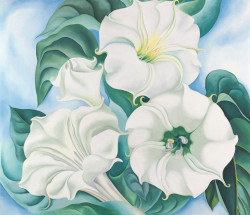At the bottom of this post, you’ll find the Georgia O’Keeffe Packet which will work well with Classical Conversations Cycle 3 Week 15 artist or in tandem with “Discovering the Great Artists: Georgia O’Keeffe” pg 86 (first edition) or pg 120 (second edition). It will also stand alone.

I confess, I’m prejudiced. I LOVE Georgia O’Keeffe’s work. Pretty much all of it. Her abstracts practically dance with color and movement…her flowers are exquisite, her bones look chiseled and polished, I love how she saw the world. Her art literally stopped me in my tracks one day when me and a bunch of other art students were jogging through an art museum, trying to get it over with. But that’s a story for another time.
O’Keeffe is, literally in many ways, undefinable. She is too realistic to fit into Abstract Expressionism. She is too Abstract to fit any “realist” label. She did things no one else was doing at the time, and had no students or followers behind her. Her style is called “American Modernism” because…she was an American and it was during the Modern Period of the Arts, but otherwise the label is completely useless.
She defied many Conventions of her time period: when she was a child, women were not professional artists. Professional art teachers, yes, I-make-my-entire-living-doing-this-artist-thing, no. She was the first woman to have her own exhibition at the Museum of Modern Art. She was one of the first to be honored as an artist first and a woman second. She was the first to break into the New York Art Scene.
But, as it turned out…Georgia wasn’t the only one.
She had an artist sister…two, in fact.
Georgia was the oldest of five sisters, and three, Ida and Catherine took up art as well. Ida, like Georgia wanted to be an artist like Georgia. She studied and went to school, studying feminine art (watercolors), but ended up following Georgia to New York City…to become a nurse.
It was only seven years later, when she was a private nurse that Ida decided to take up painting during her down time, and Georgia, along with her gallery-owner husband, helped Ida along.
Ida painted and grew popular too…trying to make sure she didn’t compete with Georgia directly (she didn’t want to be “Georgia’s Little Sister”) Ida painted under her first and middle names…Ida Ten Eyck (Ten eye-k)
Meanwhile, their little sister Catherine, married with kids, started to paint with Georgia whenever Georgia visited the home. Georgia helped Ida and Catherine display their paintings in galleries, along with watercolors their grandmothers had all done…
Until she didn’t. During a painful period when Georgia had to be hospitalized for severe depression, Georgia demanded her sisters stop painting professionally. Catherine, never wanting a serious career in art, agreed.
Ida didn’t.
The rupture was, sadly, complete. Ida and Georgia never spoke again.

After the death of Ida and the sisters she lived near (Anita and Claudia), Ida’s works were quickly auctioned off, and for many years, traded hands through garage sales, flea markets, and more.
Then, about ten years ago, Ida was re-discovered. Since then, her work has been recovered, and her paintings finding homes in museums and private collections…
But several are known to be missing. So keep your eye out, there may be an O’Keeffe out there somewhere…
Meanwhile, Georgia became a phenomenon, an artist who was a household name. She painted flowers and abstracts, and skulls, and landscapes with vibrant colors. She didn’t even let blindness stop her…assistants could stretch canvases and lay out colors and there was always sculpture. Georgia found a way to create until the very end.

So look at the O’Keefe packets for both Georgia and Ida…what do you see which looks similar, what looks different? Both Georgia and Ida had the same teachers as children and later, at college. Did that have an influence? What do you think?
If you are teaching Georgia O’Keeffe, a couple of notes to be aware of:
While most of Georgia’s works are G-rated, she does have a couple nude studies…not surprising as many artists train drawing a nude model. On the other hand, her husband/agent was a professional photographer and he did photograph Georgia a lot…and sometimes in the nude. So those photos can pop up in some Internet searches. Additionally, some people looked at Georgia’s paintings and saw parallels between her up-close flowers and intimate parts of people. Georgia always firmly rejected those perspectives, and it just goes to show that you cannot control what other people think. But that idea may come up as well, if you search in some areas.
Wikiart has a nice gallery, as does the Georgia O’Keeffe museum, if you want to explore more.
This packet was designed to go with “Discovering The Great Artists” activity for Georgia O’Keeffe, which is, of course, drawing a large flower. I have two Georgia packets: one is the usual Artist packet with bio, vocab, and reference images of the artist’s work, as well as a “Take Home” suggestion for more resources to learn about Georgia O’Keeffe at home.
The Tutor Packet contains tips, suggestions (like substituting leaves, rocks, feathers, or bones if you have students that aren’t interested in drawing flowers-these were all subjects that O’Keeffe tackled too) and reference images if getting live flowers doesn’t work right now.
Joyous Creating! Paint something big and bold!
